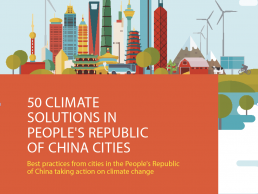First appeared in

Asian Development Bank
50 climate solutions from cities in the People's Republic of China
Specific reduction targets for each energy-intensive sector will guide the city of Qingdao in achieving its emissions targets, despite experiencing rapid economic growth.
The Qingdao Low-Carbon Development Plan, part of the second batch of the PRC low-carbon pilots, has put forward specific, systematic, and comprehensive actions and policies. The plan, running from 2014 to 2020, includes systems for spatial layout, industry, energy supply, and transportation. The plan has issued guidance for every department in the city, encouraging the local government to become low-carbon in all operations. Other PRC cities are expected follow in Qingdao’s footsteps to make low-carbon development plans.
40M
TONS OF CO2 EMISSIONS WILL BE REDUCED BY 2020, SLASHING CARBON INTENSITY PER UNIT OF GDP BY 50% FROM 2005 LEVELS.
Qingdao has established a close connection between its economic development target and mitigation target over the short, medium, and long term. Before 2020, Qingdao will focus on improving energy e¡ciency and the rationalization of its industrial structure. After 2020, transport and buildings will be the key areas of carbon emissions control. Low-carbon standards in the buildings and transport sectors will be perfected to avoid lock-in eects that could hinder the mitigation eorts. The city seeks to cut the carbon intensity level per unit of gross domestic product (GDP) by 50% in 2020 from 2005 levels.

Qingdao’s Low-Carbon Development Plan targets the energy and industry sectors in the short term before turning to buildings and transport (photo by Lie Wu).
The Challenge
Qingdao is a fast-growing city with a high proportion of manufacturing seeking to pursue further economic growth. The city’s new low-carbon plan ensures that Qingdao will not be plagued by air pollution like many neighboring cities.
Co-Benefits
Economic The city has experienced rapid economic growth, yet at the same time cut its carbon intensity, signaling healthy growth and preparing the city to decouple carbon emissions from economic growth in the future.
Environment The annual average PM2.5 concentration has decreased to around 32%. Likewise, the quality of water and soil has improved.
Health Morbidity and mortality connected to climate change-related local epidemics have been on the decline. Curbing the growth of carbon emissions can further improve air quality and the well-being of urban residents.

